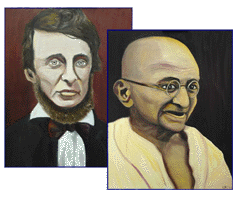"The whole aim of practical politics is to keep the populace alarmed (and hence clamorous to be led to safety) by menacing it with an endless series of hobgoblins, all of them imaginary." ~ H.L. Mencken
War: Who Goes; Who Stays
According to a list provided by our Nation's Oldest Newspaper, a large number of prominent hawks pushing for war with Iraq either dodged the draft at grad school or attained medical deferments while na've guys like me volunteered to serve. Paul Fussell, author and World War II combat vet, defined these disparities well in his best-selling book, Class. Fussell outlined nine levels of society and classified those who did the dangerous heavy lifting, such as soldiering, as mid to lower level "proles." By contrast, he explained, the rich and super rich who went to the best schools eventually attained unlimited power and made the rules that the rest of us must follow. Thus th ey attained the power to blithely send others out to die without ever stepping on a battlefield themselves or sending their sons there.
When Secretary of Defense Donald Rumsfeld, a Princeton alum serving under a Yale alum, recently described Vietnam Era draftees as adding "no value, no advantage" to the war effort I wondered why he so casually dismissed those servicemen who had little power to choose? Nearly ten million military personnel served during the Vietnam Era from 1964-1975, of which 75% of the draftees were from lower-middle or working class families. In Vietnam, amputations or crippling wounds were 300 percent higher than in World War II, yet the majority of Vietnam Era soldiers volunteered, recalling how their fathers had answered the call to arms a quarter century earlier. The Greatest Generation willingly went to war; the Greediest Generation went to Wall Street to make money after grad school. Then having attained power, or "class," they loudly call for the lower classes to do their "Patriotic duty" and rush off to war.
"It is interesting to me that many of those who want to rush this country into war and think it would be so quick and easy don't know anything about war," said Senator Chuck Hagel, a Vietnam veteran.
"They come at it from an intellectual perspective versus having sat in jungles or foxholes and watched their friends get their heads blown off."
The current crop of enlisted soldiers follows the Vietnam Era trend. Over 90% of enlisted men have no college degree according the Defense Department, while almost all those who will lead them have either a bachelor's or advanced degree. The glossy television commercials for the Army never show a single wounded soldier but offer the inducement of college tuition. But can you get money for college credits if you skip the entrance exam, the pre-emptive strike against Iraq? Many soldiers who served bravely, now question those who have never served.
What does the most decorated soldier of the Greatest Generation have to say about the ongoing occupation of Baghdad? "Concerning Iraq," wrote David Hackworth, a veteran of World War II, Korea and Vietnam, "The risk is not worth the gain. Clearly it is an oil scam, which is what it's all about." Colonel Hackworth recommended this very sobering yet instructive site which presents a soldier's perspective to the war.
At least one Powell was willing to go on record against the war with Iraq. Korean War veteran Wilson Powell spoke out at a conference in Duluth recently, "Wrapping myself in the flag and blindly following the lead of a man who has never served, into the morass of an endless war is not my way of loving and serving my country." Wilson Powell is National Administrator of the St. Louis-based Veterans for Peace.
Another veteran pressed into service during World War II was drafted from an internment camp in Hunt, Idaho and served in the 442nd Regimental Combat Team, considered by many the most decorated unit in World War II. "I joined the Army because they said the living conditions would be improved for my family at the camp," said Tsutoma "Tube" Horiuchi, a twice wounded "Nisei" or second generation Japanese American. "But nothing changed."
Horiuchi's unit followed the fighting example of the legendary Buffalo Soldiers. During the westward movement of American settlers after the Civil War, former Negro soldiers of the Union army were sent west to fight the Indians. Called Buffalo soldiers, they fought valiantly against Native Americans and served their distant Washington leaders well by doing the dirty work without really attaining any rights for themselves. The maneuver by Washington was both ingenious and diabolical: using disenfranchised former slaves as soldiers to control or eradicate disenfranchised Native Americans.
So how different is it today? How different are American troops from Buffalo Soldiers or Nisei infantrymen when one crop of Gulf War soldiers is used for a war that solved little, spawning another war that may solve even less, enriching only armament manufacturers while likely endangering everyone else?
"This is a formula for future military disaster," wrote Richard Gabriel, a former Army officer, in his book Military Incompetence. "We refused to learn from Vietnam; our refusal led to a decade in which the U.S. application of military force, five times in all, was marked by the same flaws. Our refusal to learn'does not bode well for our future."








 Reprint Rights
Reprint Rights